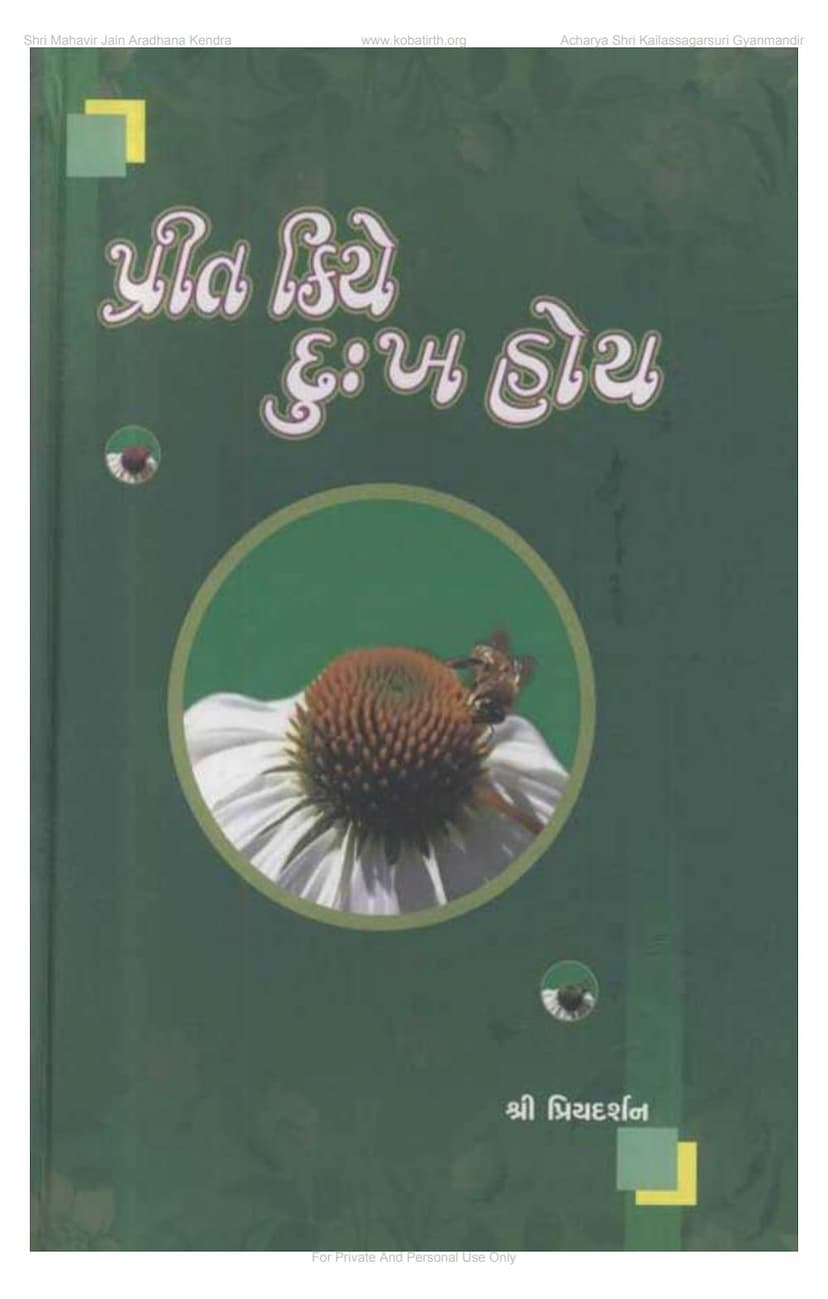Prit Kiye Dukh Hoy
Added to library: September 2, 2025

Summary
Here's a comprehensive summary of the Jain text "Prit Kiye Dukh Hoy" by Bhadraguptasuri, also known as Shri Priyadarshan:
Book Title: Prit Kiye Dukh Hoy Author: Shri Priyadarshan (Acharya Shri Vijaybhadra Guptasurishwarji M.) Publisher: Mahavir Jain Aradhana Kendra Koba
Introduction and Author's Background:
- The book "Prit Kiye Dukh Hoy" (Meaning roughly "Love leads to sorrow" or "Attachment causes suffering") is authored by Acharya Shri Vijaybhadra Guptasurishwarji M., also known by his pen name Shri Priyadarshan.
- He was born in 1989 VS (Vikram Samvat) in Pudgam, Mehsana, Gujarat. He was initiated into the Jain monastic order at the age of 18 in 2007 VS by Acharya Shrimad Vijaypremsurishwarji Maharaj.
- His literary journey began at the age of 20 with "Mahapanthano Yatri" and continued until his final days. He authored a vast body of work including philosophical treatises, critiques, long and short stories, poems, and guiding literature through letters.
- Known for his loving and cheerful nature, and a pleasant, gentle personality, Acharya Shri Guptasurishwarji was dedicated to the welfare of many. He had a keen interest in shaping the lives of the younger generation and children.
- He attained his soul's liberation (kal-dharma prapta) on November 19, 1999, in Shyamal, Ahmedabad, after facing various illnesses.
Purpose of Re-publication:
- The Shri Mahavir Jain Aradhana Kendra, Koba, decided to re-publish the works of Acharya Shri Priyadarshan after the dissolution of the Vishwakalyan Prakashan Trust, which had previously published his works.
- This initiative was undertaken with the consent of Acharya Shri Pasagarsuri, reflecting the close friendship between the two revered Acharyas. The Kendra wishes to ensure that this profound literature remains accessible to the public.
Content and Narrative:
The book primarily consists of the story "Surasundari Ras" as its foundation, originally composed by Pandit Shri Virvijayji in 1857 VS. Acharya Priyadarshan adapted this narrative. The story highlights the theme of attachment (preeti) leading to suffering.
The core narrative revolves around the lives of:
- Amar Kumar: The son of a wealthy merchant, Dhanavah. He is intelligent, accomplished, and initially friends with Suryasundari. He is shown to be influenced by his pride and misunderstanding, leading to a rift between him and Suryasundari. Later, he dedicates himself to spiritual learning under Jain Acharyas.
- Suryasundari: A princess, the daughter of King Ripumardan and Queen Ratisundari. She is virtuous, intelligent, and possesses knowledge of many arts. She experiences emotional turmoil due to misunderstandings and the consequences of attachment, particularly with Amar Kumar. She is also deeply devoted to Jain principles and seeks spiritual knowledge.
Key Themes and Events in the Narrative:
- Misunderstanding and Hurt: The story begins with a conflict between young Amar Kumar and Suryasundari over a small matter of seven coins. Amar Kumar's act of generosity (using Suryasundari's money to treat friends) is misinterpreted by her, leading to harsh words and a temporary separation. This incident highlights how pride and misunderstanding can damage relationships.
- Spiritual Growth and Learning: Both Amar Kumar and Suryasundari, after experiencing the pain of misunderstanding and the worldly distractions, turn towards spiritual learning. Amar Kumar studies under Acharya Kamal Suri, while Suryasundari seeks knowledge from Sadhvi Suvrata.
- The Power of the Navkar Mahamantra: Sadhvi Suvrata teaches Suryasundari the profound significance and power of the Shri Navkar Mahamantra. The narrative emphasizes how reciting and meditating on this mantra can protect one from dangers, bestow virtues, and lead to spiritual progress.
- Trials and Tribulations: Suryasundari faces numerous trials after being abandoned by Amar Kumar on Yaksha Island. She endures hardship, encounters dangerous beings like the Yaksha, and faces manipulative merchants like Dhananjay and Fanhahan. Throughout these adversities, her unwavering devotion to the Navkar mantra and her commitment to chastity (shil) are her sole protectors.
- The Role of Karma and Divine Intervention: The story illustrates the Jain principle of karma, where past actions (both good and bad) lead to present experiences. The intervention of benevolent forces, like the Yaksha Raja who ultimately helps Suryasundari, and the divine protection offered by the Navkar mantra, are also highlighted.
- Reunion and Spiritual Awakening: After many trials, Suryasundari is reunited with Amar Kumar in Benatata Nagar. They both realize the transient nature of worldly pleasures and the importance of spiritual pursuits. Influenced by the teachings of Jain monks and sadhvis, they eventually renounce the world and embrace the path of Jain asceticism, achieving liberation.
- The Importance of Virtue and Righteousness: The narrative consistently emphasizes the virtues of truthfulness, humility, chastity, and devotion to spiritual principles as the path to true happiness and liberation. It shows how even in the face of immense suffering, maintaining one's integrity and faith can lead to eventual salvation.
The Narrative Arc:
The story follows a detailed progression:
- The initial childhood friendship and subsequent conflict between Amar and Suryasundari.
- Suryasundari's abandonment and subsequent hardships, showcasing her resilience and devotion.
- Amar Kumar's journey, his misunderstanding, and eventual realization.
- The eventual reunion of Amar and Suryasundari.
- Their shared journey towards spiritual enlightenment and ultimate renunciation.
- The philosophical discussions and teachings embedded within the narrative, particularly concerning the Navkar Mahamantra and the principles of Jainism.
Overall Message:
"Prit Kiye Dukh Hoy" serves as a cautionary tale about the dangers of attachment, pride, and misunderstanding, while simultaneously highlighting the transformative power of faith, virtue, chastity, and spiritual devotion. It underscores the Jain philosophy that true happiness and liberation are attained through detachment from worldly desires and the rigorous practice of righteous conduct, particularly through the veneration of the Navkar Mahamantra.